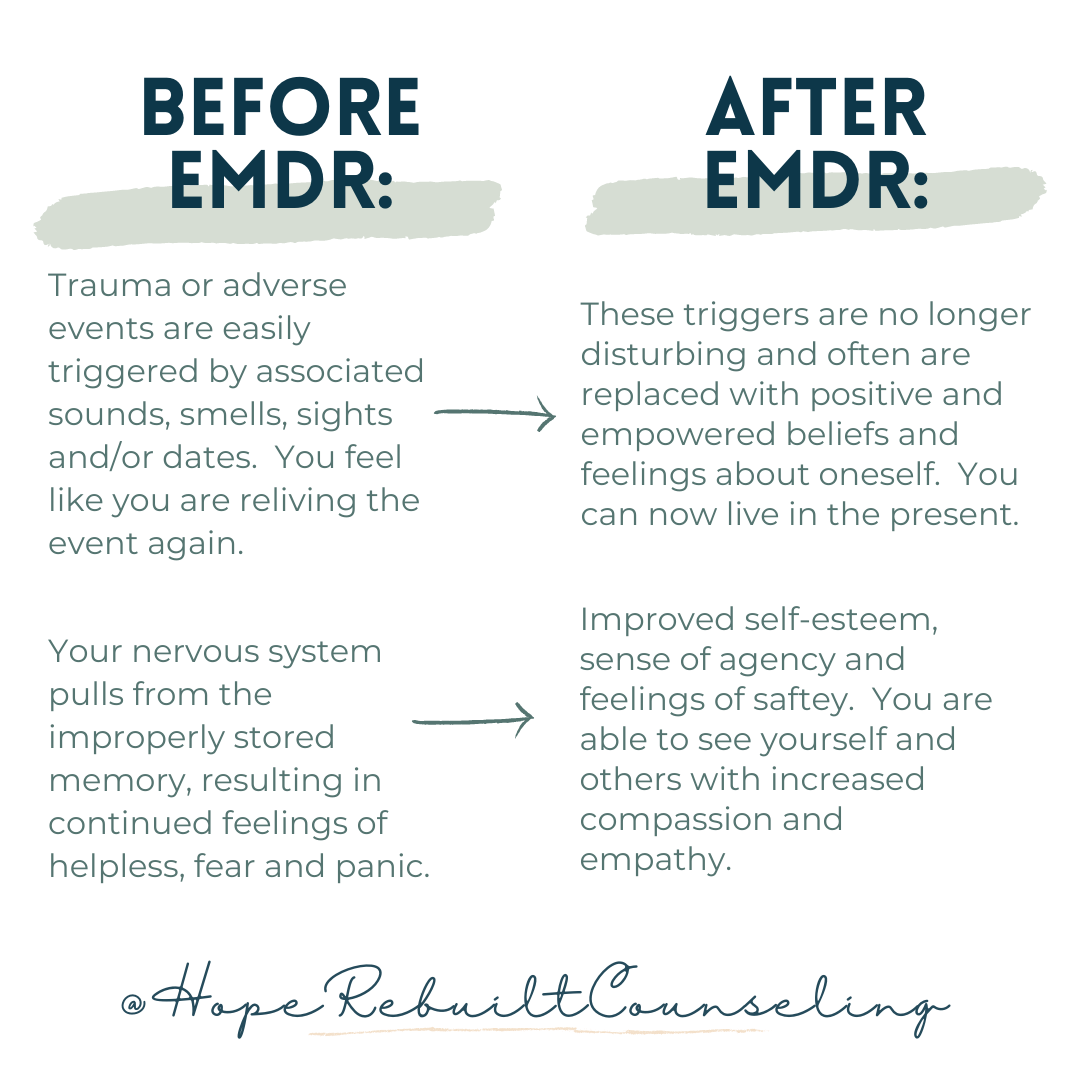What is EMDR Therapy?
Have you been curious about EMDR? Great, you came to the right place!
EMDR is a type of psychotherapy that enables people to heal from the symptoms and emotional distress that are the result of adverse life experiences. The letters stand for Eye Movement Desensitization and Reprocessing and was developed in 1988. EMDR requires providers to receive at least basic training to provide the service and offers many ongoing trainings and certification levels to make sure that therapist are offering the best treatment possible. This allows us to make sure that the therapy is being provided ethically and that the outcomes are true to what EMDR founder, Francine Shapiro intended.
So how does it work? EMDR therapy shows that the mind can in fact heal from psychological trauma much as the body recovers from physical trauma. Just like after we break a bone, we often need it “reset” and then the body’s natural healing mechanism can begin. EMDR acts like the “reset” process for the brain, allowing the brain to offer the natural healing mechanisms that it already has in place. That’s right, your brain knows how to heal itself! The therapist acts as a guide fo the process, assisting when stuck points come up. Ultimately, your brain is the one in control.
EMDR uses a set of procedures to organize your negative and positive feelings, emotions, and thoughts, and then uses bilateral stimulation, such as eye movements or alternating tapping, as the way to help you effectively work through those disturbing memories. Bilateral stimulation, also called (BLS), allows both your left brain and your right brain to communicate with each other. This is an essential factor in the healing process, as these two areas of our brain do not often share information. BLS can often be rapid sets of eye movements, much like what occurs when we sleep. During sleep, we alternate between regular sleep and REM (rapid eye movement). This sleep pattern helps you process things that are troubling you. EMDR replicates this sleep pattern by alternating between sets of eye movements and brief reports about what you are noticing. This alternating process helps you update your memories to a healthier present perspective.
The theory of EMDR focuses on the brain’s ability to constantly learn, taking past experiences, and updating them with present information. We often refer to this as our brain’s memory filing cabinet. When something gets misfiled in our memory bank, every day association can cause re-triggering and continued reliving of this experience. With EMDR, the brain is able to desensitize the disturbing images, feelings and associations that are held with the trauma. Once that has happened the brain is able to reprocess misfiled information, challenging maladaptive stored information about the event and ourselves and then releasing the sensations that they body has held.
People often ask, “What can EMDR treat?” It is designed as a “Trauma therapy” with specific approval to treat PTSD from the American Psychiatric Association, the World Health Organization and the Department of Defense. It is also studied in the treatment of and early childhood trauma, neglect and attachment wounds. But it is also highly effective in treating the everyday memories that are the reason people have low self-esteem, feelings of powerlessness, and all the myriad problems that bring them in for therapy. EMDR processing helps you break through the emotional blocks that are keeping you from living an adaptive, emotionally healthy life. Repeated studies show that by using EMDR therapy, people can experience the benefits of psychotherapy that once took years to make a difference.
EMDR does not take away your memories or change what you experienced, it simply allows your brain to feel less distressed when recalling them. It allows you to change and challenge any distorted beliefs about responsibility, effectiveness, safety or power and control that resulted from the life experiences. It gently rewires your nervous system, allowing your body to let go of the painful and uncomfortable sensations that it may be holding. For many, it is the therapy that changed their life!
If you are interested in EMDR therapy, reach out today and we would love to walk with you on the road to healing!
Writen by:
Maraeca Butler, MC, LPC-S
Lead Counselor/Clinical Supervisor/Founder and Co-owner of Hope Rebuilt
EMDRIA Certified, Approved Consultant and Facilitator

